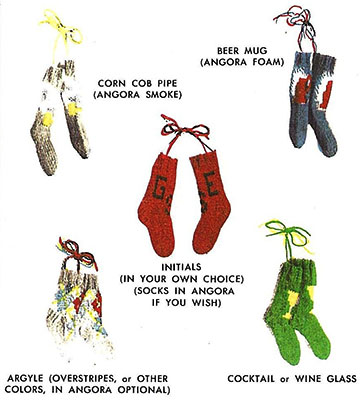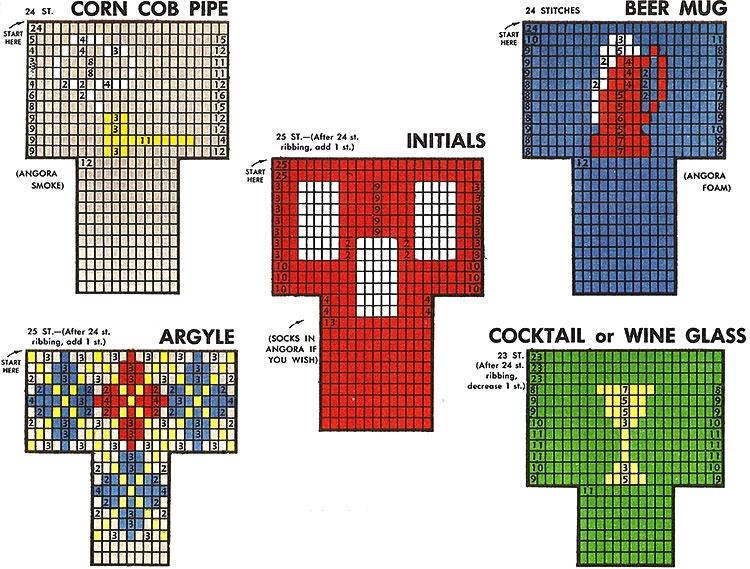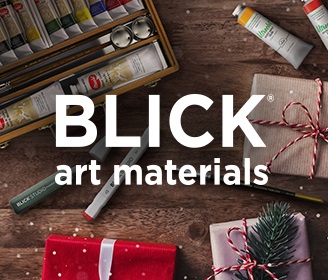Newly Added Knit Patterns
Miniature Socks Pattern #2401

Simplified multi-color knitting with color charts. Stitch sequences numbered. Each row knitted across and purled back in the same colors.
IMPORTANT
Knit across and purl back each row before starting next row. For a miniature sock approximately 4½ inches long, with ½ inch ribbing, your knitting tension should be tight enough to produce about 10 or 10½ stitches per inch using size or zero needles. If you do not obtain this gauge, change to larger or smaller needles as your particular knitting tension requires. If you wish your miniature socks to be real tiny (under 4 inches long) knit on smallest possible needles or toothpicks and obtain 11 stitches per inch. In this case you may wish to make plain part of foot quite short, and with perhaps only ¼ inch of ribbing for the cuff. Use your own choice of yarn colors.
YOUR OWN CHOICE OF 2 OR 3 INITIALS MAY BE PENCILED-IN, IN WHITE AREAS ON ABOVE GRAPH; THEN FILLING IN WHITE SQUARES REMAINING, WITH BACKGROUND COLOR (AS SHOWN RED).
NOTE:
1. In choosing yarn be sure colors selected are in good contrast to show the design in sharp detail. Since these socks are ornamental we suggest use of brighter basic colors such as RED, YELLOW, ROYAL BLUE, WHITE etc. A dark or vivid color background should be used especially for the PIPE and BEER MUG designs in order to have the WHITE ANGORA smoke, or foam, show up well. Use DARK GREY or BLACK, BROWN or BRIGHT RED, or GREEN etc. Avoid yellow, light beige, light grey and similar light shades.
2. Suggested alternate colors for the Argyle: BEIGE sock with GREEN and ORANGE diamonds and BROWN overstripes; or WHITE sock with RED and GREEN diamonds and NAVY BLUE overstripes. For the Wine Glass or Cocktail design, how about a YELLOW sock with RED glass?
3. ANGORA may be used in many interesting ways in these miniature socks. Use it, if you wish, for the overstripes of the Argyle pattern or for one or more of the diamond colors. ANGORA could also be used for the Cocktail Glass against a dark or vivid contrasting color background. For the INITIAL SOCK, a very clever effect is obtained by knitting the entire sock in ANGORA with initials in dark-color, plain yarn. You may take your choice of using 2 or 3 initials.
4. USE CARE WITH ANGORA. If used, the 100% French Angora is recommended for these designs since it is the fuzziest. However, be sure you are using a medium weight yarn. If yarn is too heavy, the large size stitches will dominate the pattern and spoil the design. In this case the finer yarn may be obtained by simply untwisting one ply of the Angora, then knitting with the part remaining.
5. Note that the numbers given on the initial pattern cover the stitch count for the background areas only, not including the areas reserved for initials. After inserting your own choice of initials and coloring-in squares remaining, with background color, then mark your own stitch count, or count squares when knitting this part.
DIRECTIONS
(5 different designs in car charms) Directions herein are complete including recommended methods for heel and toe. Detailed instructions for beginners on how to knit, purl, etc., cannot readily be given here. These are usually obtainable free, from your yarn shop.
MATERIALS—Somewhat less than ½ oz. of basic color yarn (possibly 20 yards for most designs) will usually suffice for a pair of these miniature socks. 2 to 5 yards of the individual design colors will be needed. You will probably wish to utilize your left-over scraps of yarn. Socks will be about 4½ inches in overall length, with ½ inch of ribbing, when knit regular method (knitting across and purling back each row, before starting next row) and using No. 1 needles, obtaining a gauge of 10 stitches per inch. For tiniest socks, knit on toothpicks, obtaining 11 stitches per inch. Use regular 3 ply sock yam.
IMPORTANT (Handling Yarn)—Use needles and yarn in the above accurate sizes in order to have sock of proper size per this pattern. Knitting tension should produce 10 stitches per inch. Use BOBBINS to carry your yarn in small quantities of each color. These will dangle clear of your work, avoiding entanglement. For certain small areas of color involving only a few stitches, you may prefer to merely use SHORT STRANDS of yarn, 12 to 15 inches long, dangling free, instead of bothering to wind separate bobbins. RECOMMENDATION—Make free use of additional bobbins or short strands as new color groups are encountered. A given strand will often be used over again for stitches in the same color group in the following rows, so be sure it is started long enough for the color group it is to handle. CAUTION—It is not desirable to carry one color yarn across the wrong side of another color, to reach stitches of the same color farther along the row. This would save extra strands of yarn, but in so doing the tension variation is likely to cause distortion of the stitches and thus spoil the clarity of the design. In some cases this carry-over of yarn can be accomplished satisfactorily across only one or two stitches of another color, where design detail is not too critical. Some experienced knitters can carry yarn across even more than 2 stitches and avoid a loose loop on inside of sock by twisting the yarn carried with the yarn being worked, but the danger of design distortion must be considered. You will have a more beautiful finished article if separate strands are used freely. The only inconvenience is a few more yarn ends to take care of in finishing inside of sock.
RECOMMENDATION ON BOBBINS FOR THIS PATTERN—Carry your basic color yarn on bobbins. In most cases at least 2 bobbins will be required to cover the background areas separated by the central pattern design. Use short strands for the pattern colors involving only a few stitches. In the Argyle design, short strands can also be used for the stitch groups of the basic color since the background is so broken up by the other colors of the design. Diamond and background colors in the Argyle may be carried across the single stitches of the yellow overstripes, to avoid having so many loose yarn ends on inside of sock. Be careful with knitting tension to keep stitches of uniform size so pattern design will not be distorted.
LEG PATTERN—This part of sock is knitted in a flat piece, eventually to be folded and sewed together up the back. First cast on 24 stitches of basic color and knit 2, purl 2, for ribbing for ½ inch. Knit the pattern rows as shown on the graph of the particular design selected. Purl each row back to the beginning before starting the next row. Each pattern row thus represents 2 rows of usual knitting. Numbers are shown on graph to indicate stitch count for various groups of stitches. In changing colors always twist yarns around each other once to avoid leaving a hole. Knit the successive rows of the leg part of pattern after which work separates into instep and heel.
INSTEP—Divide the stitches, taking the designated number off each end, and place on separate needles or safety pin for the heel. The heel may be knit at this point for those designs where the instep is a plain color. For the Argyle and Initial designs, continue the pattern down the instep, using the center stitches only. When pattern design is complete, down to plain color, then discontinue on this part and knit the heel.
HEEL—Place the 2 groups of stitches previously divided from the instep, on one needle. This folds the main pattern, or leg of sock, into position for sewing up the back later. (The reinforced type of heel should be used, to carry out the exact miniature representation of a real sock.)
Using 12 HEEL STITCHES (all designs except Argyle). slip 1, knit 1 in sequence for the 1st row, then purl back. Continue thus in successive rows for ½ inch. On the last purl row, purl 6 stitches, then purl 2 together, purl 1 and turn work. Then:
Knit back 3, knit 2 together, knit 1, turn
Purl back 3, purl 2 together, purl 1, turn
Knit back 3, knit 2 together, knit 1, turn
… etc.
Continue in this manner, advancing 1 stitch at each end of each row in this order and thus making rounded bottom of heel, until all stitches are used, (ending up with 5 stitches on last row. This plan (requiring 7 rows for rounded bottom) lengthens the base of heel slightly and produces a nice curved-down shape to heel of your sock.
Using 16 HEEL STITCHES (for Argyle) proceed as above, except on last purl row, purl 9 stitches, then purl 2 together, purl 1, and turn work. Then:
Knit back 5, knit 2 together, knit 1, turn
Purl back 5, purl 2 together, purl 1, turn
Knit back 5 … etc.
… etc.
You should end up with 7 stitches after the 9th row, which is a purl row.
Now pick up 6 stitches along each of the 2 forward edges of the heel thus knitted, and add to the work in progress along bottom of heel. Divide all of these heel stitches evenly on 2 needles.
ANKLE (For ARGYLE and INITIALS) Now knit a row, purl a row alternately, and decrease 1 stitch on each side of foot on each knit row only, to form ankle gusset. When only 15 stitches (Argyle) remain on these 2 underfoot needles (11 stitches for initials), continue without further decreasing until underfoot part evens up with instep pattern previously completed. Then join all work on 3 needles, so that there are 12 stitches on instep needle, 6 ea. on the 2 underfoot needles. With a 4th working needle continue plain knitting round and round until within ½ inch of desired length of foot, then start decreasing to shape toe. (With Argyle you will probably start shaping toe at once, as soon as all work is joined together).
ANKLE and INSTEP (For PIPE, MUG, & GLASS). At this point entire work is on 3 needles,—instep needle with 11 or 12 stitches which must be kept separate, and the 2 underfoot (heel) needles on which the stitches along edge of finished heel are evenly divided. Use a 4th working needle and knit plain color foot round and round and form triangular gusset of Ankle by decreasing 1 stitch at the forward point of each underfoot needle on EVERY OTHER ROW until only 6 stitches remain on each underfoot needle (and with 12 stitches on instep needle). Continue without further decreasing until within ½ inch of desired length of foot.
TOE—Shape toe as follows: Decrease 4 stitches on every other row, these being the end stitches on the instep needle, and the stitches next to these, one on each underfoot needle. When only 8 stitches remain (4 on instep needle and 4 on underfoot needles) then weave toe as follows: Place yarn in a tapestry needle and, with yarn coming from back of knitting needle, put it in first stitch of front (instep) needle as if to knit, and slip it off. Then put it in next stitch of front needle as if to purl and leave it on. Go to back (underfoot) needle and insert as if to purl and take it off, then to next stitch of back needle as if to knit and leave it on. This designation may assist:
Front needle K—off, P—on
Back needle P—off, K—on
Repeat thus to the end of the 4 stitches on each needle.
FINISH—Finish inside of sock by weaving thread ends into nearby seams, trimming ends, etc. Sew sock up back (using corresponding color yarn on a tapestry needle. For Argyle and Initial designs, sew foot of sock up on each side where instep pattern was knitted separately from lower foot in that area. Shape and press finished socks if you wish to display them flat, or stuff with cotton if you prefer them to have a rounded appearance. Attach complete socks together with strands of colored yarn for hanging up in your car or elsewhere for display.
GENERAL DIRECTIONS
Each square equals one stitch, knitted and/or purled. Sequences of stitches in particular colors to form a pattern are shown in color and by numbers on the specific pattern graphs. This saves counting squares. The number of row and number of stitches in each, depend on the symmetry of the pattern design, also on the approximate size of sock desired in order to fit the wearer's leg. Size and dimensions are indicated in each particular pattern.
Each row is normally knitted and purled back in the same colors. For certain patterns which are easily repeated, the knitter may, in purling back, go to the next row. In this case the indicated pattern will be reduced in size by one-half, and the entire pattern must then be repeated in order to achieve the length indicated.
Heel, bottom of foot, and toe are knitted in the manner of plain socks. In certain patterns where the instep is a plain color, and the same color as the foot, this part of the sock may be knitted round and round as in plain socks.

| Pattern Categories Browse the categories to help you find the patterns you're looking for. |
||
|
||










